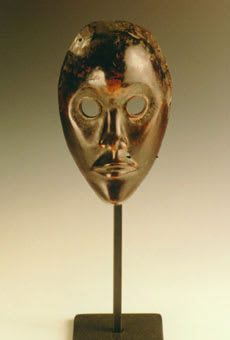Dan Wooden Gunye Ge or Zapkei Ge Mask, 1870 CE - 1920 CE
Wood
4.875 x 8.25
PF.1447
The life of the Dan people is governed by the Poro society, an organization for men that trains and initiates boys in the community’s laws and in general maintains order...
The life of the Dan people is governed by the Poro society, an organization for men that trains and initiates boys in the community’s laws and in general maintains order and traditions. Many different masks are used for the society’s ceremonies. Judges, protectors, diviners, and watchmen all have an identifying mask type, and others are made to use in circumcision rites, to guard against trespassers, and to collect food that is brought back to the boys in their Poro initiation camps. One form is even worn by a guardian who sees that women extinguish their fires at noon in the dry season.
The rounded features, delicate carving, and finely polished surface characteristic of Dan masks make them among the most popular and highly appreciated types of all African art. The oval shape of the mask with its finely carved features including the high forehead, demarkated eyebrows, and strongly protruding mouth with pursed lips indicates that this is probably the work of the northern Dan peoples. The circular eyes that permit unhindered vision on the part of the wearer are characteristic of the racer mask (gunye ge) and the fire mask (zakpei ge), two mask types originating in the north. The gunye ge hold weekly running contests during the dry season to test the prowess of young warriors. The zapkei ge also appear at this time of the year to inspect cooking fires and prevent possible spreading. A fibrous wig and beard would have originally filled the holes around the rim of the mask while a patch of fur remains intact, replicating a moustache. This wig would have covered up the scarf that the wearer had to wrap around his head as a rule to further conceal the dancer’s identity. This mask is a masterpiece of woodcarving; it is evocative but not imitative of the human form and originally served a sacred ceremonial purpose. All these aspects make the mask an epitome of African art that can be easily embraced and lauded by Western aesthetic tastes.
The rounded features, delicate carving, and finely polished surface characteristic of Dan masks make them among the most popular and highly appreciated types of all African art. The oval shape of the mask with its finely carved features including the high forehead, demarkated eyebrows, and strongly protruding mouth with pursed lips indicates that this is probably the work of the northern Dan peoples. The circular eyes that permit unhindered vision on the part of the wearer are characteristic of the racer mask (gunye ge) and the fire mask (zakpei ge), two mask types originating in the north. The gunye ge hold weekly running contests during the dry season to test the prowess of young warriors. The zapkei ge also appear at this time of the year to inspect cooking fires and prevent possible spreading. A fibrous wig and beard would have originally filled the holes around the rim of the mask while a patch of fur remains intact, replicating a moustache. This wig would have covered up the scarf that the wearer had to wrap around his head as a rule to further conceal the dancer’s identity. This mask is a masterpiece of woodcarving; it is evocative but not imitative of the human form and originally served a sacred ceremonial purpose. All these aspects make the mask an epitome of African art that can be easily embraced and lauded by Western aesthetic tastes.
